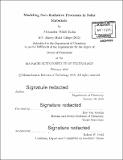| dc.contributor.advisor | Troy Van Voorhis. | en_US |
| dc.contributor.author | Kohn, Alexander Wolfe | en_US |
| dc.contributor.other | Massachusetts Institute of Technology. Department of Chemistry. | en_US |
| dc.date.accessioned | 2018-05-23T16:35:42Z | |
| dc.date.available | 2018-05-23T16:35:42Z | |
| dc.date.copyright | 2018 | en_US |
| dc.date.issued | 2018 | en_US |
| dc.identifier.uri | http://hdl.handle.net/1721.1/115806 | |
| dc.description | Thesis: Ph. D., Massachusetts Institute of Technology, Department of Chemistry, 2018. | en_US |
| dc.description | Cataloged from PDF version of thesis. | en_US |
| dc.description | Includes bibliographical references (pages 89-102). | en_US |
| dc.description.abstract | In this thesis, we investigate methods and systems for understanding the electronic properties of a variety of systems relevant to organic photovoltaics. The second chapter examines how to predict the radiative and non-radiative decay rates of a large family of naphthalene derivatives. Naphthalene is a common building block in many organic electronic devices and possesses complex photophysics that are difficult to capture. Principally using time-dependent density functional theory, we are able to reproduce the experimental rates and, moreover, the fluorescence quantum yield, quite accurately. The next chapter then goes into extensions of the methodology discussed and analyzed in the prior chapter. Anthracene derivatives used for transferring triplet energy between a quantum dot and rubrene phase are found to have varying impacts on the total transfer efficiency based on the triplet lifetime of the anthracene derivative. Most potently, significant spin-orbit coupling in some of the derivatives causes substantial deactivation. An additional family, BODIPY dyes, is also investigated. They are found to undergo internal conversion gated by an excited-state conformational change, suggesting this may be a common motif. The fourth and fifth chapters investigate different interfacial effects and their impacts on the energy levels of electrons and holes in disordered organic devices. They look at specific systems: the interface between three different donors, PPV, P3HT, PTB7, and PCBM. They find that the interface can both reduce and induce disorder in different systems and that full treatment of the electronic environment is important for capturing accurate results. The final chapter investigates the use of neural networks to predict optimal range-separation parameters for density functionals. | en_US |
| dc.description.statementofresponsibility | by Alexander Wolfe Kohn. | en_US |
| dc.format.extent | 102 pages | en_US |
| dc.language.iso | eng | en_US |
| dc.publisher | Massachusetts Institute of Technology | en_US |
| dc.rights | MIT theses are protected by copyright. They may be viewed, downloaded, or printed from this source but further reproduction or distribution in any format is prohibited without written permission. | en_US |
| dc.rights.uri | http://dspace.mit.edu/handle/1721.1/7582 | en_US |
| dc.subject | Chemistry. | en_US |
| dc.title | Modeling non-radiative processes in solar materials | en_US |
| dc.type | Thesis | en_US |
| dc.description.degree | Ph. D. | en_US |
| dc.contributor.department | Massachusetts Institute of Technology. Department of Chemistry | |
| dc.identifier.oclc | 1036988284 | en_US |
